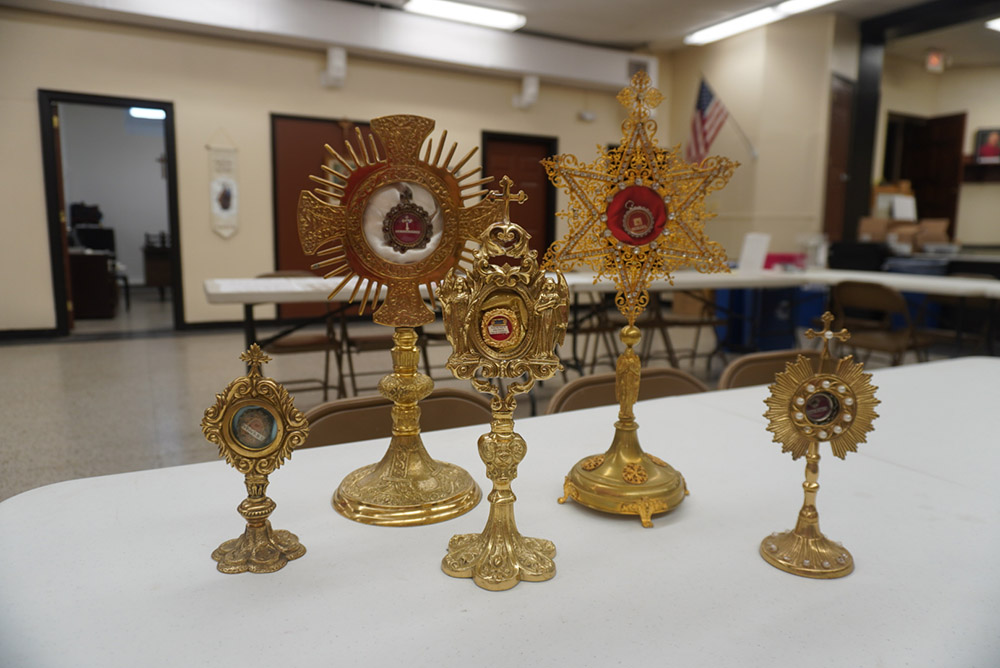
MONTCLAIR, New Jersey — Joseph Santoro has recognized the importance of Catholic relics since he was just a teenager in Williamsburg. His Italian great-grandparents maintained devotion to several saints while attending Our Lady of Mount Carmel, and he was still in high school when he was given his first relic at the Shrine of St. John Neumann.
He immediately recognized that relics were “treasures of the church” that needed to be protected.
Now, with more than 400 in his possession, Santoro has devoted himself to “rescuing relics” across the world. These holy items do not belong in storage or for individual, private devotion, he says. They belong at places of worship or in public spaces, so the faithful can properly venerate them.
On Saturday, Feb. 24, he brought about 200 authenticated relics to Our Lady of Mount Carmel Oratory in Montclair, New Jersey. Approximately 3,000 faithful from across the United States visited the oratory to bear witness and venerate these relics – at one point, the line stretched down two blocks.
They included a splinter from the Crown of Thorns, a scarf that belonged to Mother Cabrini, and pieces of the Virgin Mary’s veil as well as the Christ Child’s crib.
“They have no magical powers. Your faith, through the intercession of these particular saints, martyrs, and blesseds, can bring the highest of highs,” he said.
Both first-class and second-class relics were displayed at the oratory, for both saints and Blessed people like Carlo Acutis. Attendees were encouraged to bring personal items and make their own third-class relics — objects that touched a first-class or second-class relic — for prayer. Santoro hopes that this event will be the first of many opportunities to share his relics on a larger scale.
Santoro is the regional delegate to the United States for the International Crusade for Holy Relics (ICHR), an international movement for the preservation and veneration of relics. Hundreds of people across the globe are part of the group, based in Fatima, Portugal, and it is recognized by the Bishop of Fatima. Santoro spends his money on the rescue of the relics on behalf of the ICHR, taking them to places of worship or to individuals who wish to pray for an intercession by the saint.
It was a blessing, Father Giandomenico Flora said, to have these relics for veneration in the Archdiocese of Newark. As the rector at Our Lady of Mount Carmel Oratory, he says the relics serve as a reminder about the lives of saints and how all faithful are called towards sainthood.
“It’s important to become aware that all of us are called to holiness through our baptism, and this is what it means to evangelize. To make people aware that the call to holiness is not only for Padre Pio and St. Francis of Assisi,” Father Flora said.
Selling relics is “absolutely forbidden” according to canon law. However, individuals will try to purchase them through black markets and online at places like eBay. As a layperson, however, Santoro is permitted to have them in his home and to do exhibits by the Bishop of Fatima because of his involvement with the ICHR.
“I feel good at the end of the day, especially after I save a relic, because you never know whose hands these are going to wind up in,” Santoro said.
ICHR is not the only Catholic organization working to save relics from misuse. The Apostolate for Holy Relics is a nonprofit organization that has collected over 1,200 relics from illegal auctions and eBay.
“The whole thing is pretty seedy when you start to sell these,” Thomas Serafin, founder and president of the Apostolate for Holy Relics, told the Tablet in August. “Because now you’re taking advantage of somebody’s faith.”
Oftentimes, supposed relics sold online are counterfeit. As such, Santoro has a detailed process that allows him to ensure that any relics he saves truly belonged to the saints, Blessed individuals, or martyrs. He checks the theca, or the piece of paper that identifies the relic, to see if it is truly inked or if it’s printed paper.
Relics are accompanied by authenticated documents, which contain descriptions of the relic and the reliquary containing the relic. Santoro checks to make sure the seal on the inside back of the reliquary matches that of the priest or bishop who authenticated it. He even checks penmanship.
“Some groups are evil. Some groups are just curious, and some groups are people who just don’t know what they are, and they just sit in a box somewhere. A relic belongs in a place of honor where people can come to venerate and pray with the relic through the intercession of that particular saint to Almighty God,” Santoro said.
